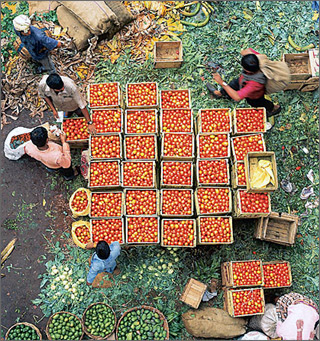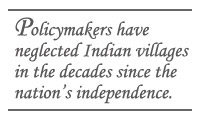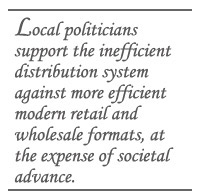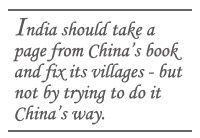India’s Forgotten Farmers
India’s Forgotten Farmers

pittance at government-run markets; time to open the door to urban markets
BOSTON: India’s economic rise is the story du jour. But for all its much-delayed embrace of globalization, 70 percent of India’s citizens remain condemned to rural isolation, unable to link to the global networks that could catapult them from poverty. A major part of the solution to this dilemma lies in leveraging India’s entrepreneurial classes and willing foreign investors to link urban markets with their rural farming hinterlands. This private-sector catalyst is different from that used in China in its state-led 1980s agricultural reform.
Recently, I trudged through the slush of a government-run food auction yard, or mandi, in Bangalore, offshoring capital of the world: Piles of produce lay everywhere, rotting in the sun and competing with mangy dogs and scampering mice for my attention. Huddles of impecunious farmers, wearing the traditional dhoti, wore resigned looks. A government agent, pen tucked behind ear, offered a pittance for the produce on display.

The farmers’ day began in the pre-dawn hours, with multi-mode transport to the auction yard — ramshackle buses, bullock carts, trucks, even tractors chugging along the narrow, so-called “highways.” Produce unloaded, the farmers accept whatever they get since every day away from the farm is lost income. After snatching a few hours’ sleep in a shady corner, they retrace their steps home.
India’s awkwardly named Agricultural Produce Marketing Committees (APMC) Act mandates that agricultural products be purchased through such wholesale yards, making the mandi a monopoly controlled by local political interests, a perversion of the original purpose of freeing poor farmers from moneylenders’ clutches. Farmers remain exploited, just by someone else now.
The hapless farmers’ urban sojourn is a continuation of the rural nightmare of a daily hand-to-mouth struggle. Policymakers have neglected Indian villages in the decades since the nation’s independence: 89 percent of rural households do not own telephones; 52 percent do not have any domestic power connection. The average brownout in India is three hours per day during non-monsoon months, 17 hours daily during the monsoon. The average village is 2 kilometers away from an all-weather road, and 20 percent of rural habitations have partial or no access to a safe drinking-water supply.

The contrast with rural China is stark. Around the time I visited Bangalore, I crisscrossed parts of Henan province – the name means “south of the Yellow River,” or Huanghe. The province, one of China’s most populous, is home to more than 100 million people. I started in Zhengzhou, the capital, a major industrial center and railway junction, and traveled to Chengguan, a county government seat, scrupulously clean, with municipal services apparent even in the pre-dawn hours. I then headed to the small Qiu village, population no more than a few thousand. Paved roads leading to the cornfields at the village’s edge were in better condition than the Massachusetts Turnpike and other highways I know at home. The village itself indicated if not prosperity, then at least the absence of the desperation of many Indian villages.
B.R. Ambedkar, framer of India’s Constitution and a critic of Gandhi’s model of village-centered development, famously said in 1948, “What is the village but a sink of localism, a den of ignorance, narrow mindedness and communalism?” Indeed, for all the talk of India shining, there’s been scant progress in the villages.
The development paths of other countries explain why this is serious. Usually, agricultural development in rural areas generates economic surpluses, which catalyze light manufacturing in rural and semi-urban areas, and ultimately industrialization in the urban areas. The economic surplus allows reinvestment in new technology and releases human capital for broader-based development. China followed this path post-1978, as did Indonesia as early as 1966 and, more recently, Vietnam in 1989.

The Indian government, for all its official worship of Gandhi, failed to invest adequately in villages. With corporate India and civil society, the track record is brighter. For example, the Self-Employed Women’s Association (SEWA), centered in Gujarat, has empowered hundreds of thousands of women through a myriad of small projects catering to health, elementary education and economic self-sufficiency by providing them small loans to start productive livelihoods. Companies like Hindustan Unilever and ITC (Indian Tobacco Company), among others, have long had distribution networks into village India, providing some investment, goods and services in areas beyond the government’s reach. Particularly encouraging are joint ventures such as those between SEWA and ITC. Corporate muscle multiplies the benefits that civil society can bring to rural India.
Alas, though, these efforts are too little, too late. The state government has not always supported SEWA, perhaps sometimes feeling threatened by the unified block of votes its large membership base represents. Organized investment in the retail and wholesale sector has often met its match at the hands of the unorganized trade that it would likely supplant: Witness protests against both indigenous retailers like Reliance Fresh and German wholesaling giant Metro Cash and Carry. Retail trade employs 8 percent of India’s population, the largest employer after agriculture. There are more than 12 million small retailers in India, 96 percent of whom are small mom-and-pop stores, each occupying less than 500 square feet, creating the highest retail-outlet density per capita in the world. In India’s democracy, small retailers count for many votes, and so local politicians support the inefficient distribution system against more efficient modern retail and wholesale formats, even at the expense of societal advance.
Mandis, in a sense, perpetuate system-wide inefficiency, and unorganized retail does not have the wherewithal to attack the system forthwith. The farmer continues to be beholden to the local monopolist for distributing his produce. One study suggests that tomato farmers in Karnataka, for example, received rupees 2 per kilogram, compared to the end-user price of rupees 8.20. Thus, the misery of the villages continues apace.
Well-meaning pundits assert that the government should “do something.” Indeed, the highest echelons of the government concur. India’s finance minister, P. Chidambaram, has spoken out against the APMC Act, recognizing it as an unfortunate anachronism. But even this august personage’s ability to dictate to the local satraps is limited.
In these circumstances, the most expedient course of action is to search for multipliers of civic action and grassroots movements that empower villagers. After all, modern China’s economic revolution started in the reform of its village enterprises, the result of an unwitting experiment in individual accountability by farmers in Anhui province. The Croesus-like riches in the form of foreign direct investment followed China’s rural reform.

So India should take a page from China’s book and fix its villages, but not by trying to do it China’s way. China’s strong government forced the rapid dissemination of the Anhui experiment. India’s weak state cannot accomplish anything remotely comparable. Rather, India should play to its private-sector strengths. Corporations need a seat at the table of village reform. India’s vibrant indigenous entrepreneurial class – unlike China’s counterpart, largely decimated by the socialist experiment and the Cultural Revolution – must be courted. Reliance Fresh is an indigenous example in India. Even multinationals should be welcomed, the task is so enormous. Metro Cash and Carry is an example, and joint ventures between indigenous entrepreneurs like Bharti Enterprises and multinationals like Wal-Mart can complete the private-investment picture. A modern agricultural supply chain linking the village tomato farmer to his urban market could reduce waste by 25 percent and end-user prices by 21 percent.
Only then will the 70 percent living in villages begin to share in India, allegedly “rising” today.
Tarun Khanna is the Jorge Paulo Lemann Professor at Harvard Business School and author of “Billions of Entrepreneurs: How China and India are Reshaping their Futures and Yours,” published this month by the Harvard Business School Press (Penguin in Asia). Click here to read an excerpt.